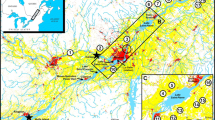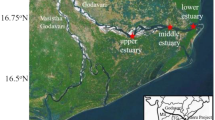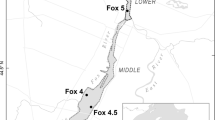Abstract
To determine the possible contributions of point and non-point sources to carbon and nutrient loading in the Ganga River, we analyzed N, P, and organic carbon (OC) in the atmospheric deposits, surface runoff, and in the river along a 37-km stretch from 2013 to 2015. We also assessed the trophic status of the river as influenced by such sources of nutrient input. Although the river N, P, and productivity showed a declining trend with increasing discharge, runoff DOC and dissolved reactive phosphorus (DRP) increased by 88.05 and 122.7% between the Adpr and Rjht sites, indicating contributions from atmospheric deposition (AD) coupled with land use where agriculture appeared to be the major contributor. Point source input led to increased river concentrations of NO3 −, NH4 +, DRP, and DOC by 10.5, 115.9, 115.2, and 67.3%, respectively. Increases in N, P, and productivity along the gradient were significantly negatively correlated with river discharge (p < 0.001), while river DOC and dissolved silica showed positive relationships. The results revealed large differences in point and non-point sources of carbon and nutrient input into the Ganga River, although these variations were strongly influenced by the seasonality in surface runoff and river discharge. Despite these variations, N and P concentrations were sufficient to enhance phytoplankton growth along the study stretch. Allochthonous input together with enhanced autotrophy would accelerate heterotrophic growth, degrading the river more rapidly in the near future. This study suggests the need for large-scale inter-regional time series data on the point and non-point source partitioning and associated food web dynamics of this major river system.











Similar content being viewed by others
References
Alvarez-Cobelas, M., Angelar, D. G., & Sanchez-Carrillo, S. (2008). Export of nitrogen from catchments: a worldwide analysis. Environmental Pollution, 156, 261–269.
American Public Health Association. (1998). Standard methods for the examination of water and wastewater. Washington: APHA.
Aneja, V. P., Schlesinger, W. H., Erisman, J. W., Behera, S. N., Sharma, M., & Battye, W. (2012). Reactive nitrogen emissions from crop and livestock farming in India. Atmospheric Environment, 47, 92–103.
Beman, J. M., Arrigo, K. R., & Matson, P. A. (2005). Agricultural runoff fuels large phytoplankton blooms in vulnerable areas of the ocean. Nature, 434, 211–214.
Berggren, M., Bergström, A. K., & Karlsson, J. (2015). Intraspecific autochthonous and allochthonous resource use by zooplankton in a humic lake during the transitions between winter, summer and fall. PloS One, 10(3), e0120575.
Bergstrom, A. K., Jonsson, A., & Jansson, M. (2008). Plankton responses to nitrogen and phosphorus enrichment in unproductive Swedish lakes along a gradient of atmospheric nitrogen deposition. Aquatic Biology, 4, 55–64.
Bernot, M. J., Sobota, D. J., Hall, R. O., Mulholland, P. J., Dodds, W. K., Webster, J. R., Tank, J. L., Ashkenas, L. R., & Cooper, L. W. (2010). Inter-regional comparison of land-use effects on stream metabolism. Freshwater Biology, 55, 1874–1890.
Bowes, M. J., Leach, D. V., & House, W. A. (2005). Seasonal nutrient dynamics in a chalk stream: the River Frome, Dorset, UK. Science of the Total Environment, 336, 225–241.
Bowes, M. J., Smith, J. T., Jarvie, H. P., & Neal, C. (2008). Modelling of phosphorus inputs to rivers from diffuse and point sources. Science of the Total Environment, 395(2–3), 125–138.
Boyer, E. W., Goodale, C. L., Jaworski, N. A., & Howarth, R. W. (2002). Anthropogenic nitrogen sources and relationships to riverine nitrogen export in the northeastern U.S.A. Biogeochemistry, 57(58), 137–169.
Caraco, N. F. (1995). Influence of human populations on P transfers to aquatic ecosystems: a regional scale study using large rivers. In H. Tiessen (Ed.), Phosphorus in the global environment (pp. 235–244). New York: John Wiley and Sons.
Caraco, N. F., & Cole, J. J. (1999). Human impact on nitrate export: an analysis using major world rivers. Ambio, 28, 167–170.
Carlson, R. E. (1977). A trophic state index for lakes. Limnology and Oceanography, 22, 361–369.
Carpenter, S. R., Caraco, N. F., Correll, D. L., Howarth, R. W., Sharpley, A. N., & Smith, V. H. (1998). Nonpoint pollution of surface waters with phosphorus and nitrogen. Ecological Applications, 8, 559–568.
Central Pollution Control Board (2013). Pollution assessment: River Ganga. Ministry of Environment and Forests, Govt. of India, Parivesh Bhawan, Delhi, India.
Chen, N., & Hong, H. (2011). Nitrogen export by surface runoff from a small agricultural watershed in southeast China: seasonal pattern and primary mechanism. Biogeochemistry, 106, 311–321.
Chen, H., Teng, Y., Yue, W., & Song, L. (2013). Characterization and source apportionment of water pollution in Jinjiang River, China. Environmental Monitoring and Assessment, 185, 9639–9650.
Clow, D. W., & Campbell, D. H. (2008). Atmospheric deposition and surface water chemistry in Mount Rainier and North Cascades Mational Parks, U.S.A., Water Years 2000 and 2005–2006. Prepared in Cooperation with the National Park Service Scientific Investigation Report 2008–5152. U.S. Geological Survey, Reston, Verginia.
Daniel, M. H. B., Montebelo, A. A., Bernardes, M. C., Ometto Jean, P. H. B., De Camargo, P. B., Krusche, A. V., Ballester, M. V., Victoria, R. L., & Martinelli, L. A. (2002). Effects of urban sewage on dissolved oxygen, dissolved inorganic and organic carbon, and electrical conductivity of small streams along a gradient of urbanization in the Piracicaba river basin. Water, Air, and Soil Pollution, 136, 189–206.
Diatloff, E., & Rengel, Z. (2001). Compilation of simple spectrophotometric techniques for the determination of elements in nutrient solutions. Journal of Plant Nutrition, 24, 75–86.
Dodds, W. K., & Cole, J. J. (2007). Expanding the concept of trophic state in aquatic ecosystems: it’s not just the autotrophs. Aquatic Sciences, 69, 427–439.
Dumont, E., Harrison, J. A., Kroeze, C., Bakker, E. J., & Seitzinger, S. P. (2005). Global distribution and sources of dissolved inorganic nitrogen export to the coastal zone: Results from a spatially explicit, global model. Global Biogeochemical Cycles, 19, GB4S02. https://doi.org/10.1029/2005GB002488.
Fluck, R. C., Fonyo, C., & Flaig, E. (1992). Land-based phosphorus balances for Lake Okeechobee, Florida drainage basins. Applied Engineering in Agriculture, 8, 813–820.
Fu, G. T., Butler, D., & Khu, S. T. (2009). The impact of new developments on river water quality from an integrated system modeling perspective. Science of the Total Environment, 407(4), 1257–1267.
Hagen, E. M., Mc Tammany, M. E., Webster, J. R., & Benfield, E. F. (2010). Shifts in allochthonous input and autochthonous production in streams along an agricultural land-use gradient. Hydrobiologia, 655, 61–77.
He, B., Kanae, S., Oki, T., Hirabayashi, Y., Yamashiki, Y., & Takara, K. (2011). Assessment of global nitrogen pollution in rivers using an integrated biogeochemical modelling framework. Water Research, 45, 2573–2586.
Jain, C. K., Bhatia, K. K. S., & Seth, S. M. (1998). Assessment of point and non-point sources of pollution using a chemical mass balance approach. Hydrological Sciences Journal, 43, 379–390.
Jarvie, H. P., Neal, C., & Withers, P. J. A. (2006). Sewage-effluent phosphorus: a greater risk to river eutrophication than agricultural phosphorus? Science of the Total Environment, 360, 246–253.
Jeunesse, I. L., Deslous-Paoli, J. M., Xim, M. C., Cheylan, J. P., Mende, C., Borrero, C., & Scheyer, L. (2002). Changes in point and non-point sources phosphorus loads in the Thau catchment over 25 years (Mediterranean Sea–France). Hydrobiologia, 475(476), 403–411.
Kebede, M. T., Nair, A. S., & Dawit, M. (2014). The impact of urban and rural land use types on water quality of Meki River in Sodo Wereda, Gurage zone, Snnprs, Euthopia. Journal of Aquatic Biology and Fisheries, 2, 376–389.
Liu, J., & Diamond, J. (2005). China’s environment in a globalizing world. Nature, 435(7046), 1179–1186.
Lundy, L., & Wade, R. (2013). A critical review of methodologies to identify the sources and pathways of urban diffuse pollutants. Stage 1 contribution to: Wade, R et al. (2013) A critical review of urban diffuse pollution control: Methodologies to identify sources, pathways and mitigation measures with multiple benefits. CRW2012/1, Available online at: crew.ac.uk/publications.
Lau, D. C. P., Leung, K. M. Y., & Dudgeon, D. (2009). What does stable isotope analysis reveal about trophic relationships and the relative importance of allochthonous and autochthonous resources in tropical streams? A synthetic study from Hong Kong. Freshwater Biology, 54, 127–141.
Mahowald, N. M., Baker, A. R., Bergametti, G., Brooks, N., Duce, R. A., Jickells, T. D., Kubilay, N., Prospero, J. M., & Tegen, I. (2005). The atmospheric global dust cycle and iron inputs to the ocean. Global Biogeochemical Cycles, 19, GB4025. https://doi.org/10.1029/2004GB002402.
Maiti, S. K. (2001). Handbook of methods in environmental studies. Water and wastewater, vol 1. Jaipur: ABD.
Mekonnen, M. M., & Hoekstra, A. Y. (2015). Global gray water footprint and water pollution levels related to anthropogenic nitrogen loads to fresh water. Environmental Science and Technology, 49, 12860–12868.
Merseburger, G. C., Marti, E., & Sabater, F. (2005). Net changes in nutrient concentrations below a point source input in two streams draining catchments with contrasting land uses. Science of the Total Environment, 347, 217–229.
Merseburger, G., Martí, E., Sabater, F., & Ortiz, J. D. (2011). Point-source effects on N and P uptake in a forested and an agricultural Mediterranean streams. Science of the Total Environment, 409, 957–967.
Michel, P. (1984). Ecological methods for field and laboratory investigation. New Delhi: Tata McGraw–Hill Publishing Company.
Misra, A. K. (2011). Impact of urbanization on the hydrology of Ganga Basin (India). Water Resource Management, 25, 705–719.
Mouri, G., Takizawa, S., & Oki, T. (2011). Spatial and temporal variation in nutrient parameters in stream water in a rural-urban catchment, Shikoku, Japan: effects of land cover and human impact. Journal of Environmental Management, 92, 1837–1848.
Munafo, M., Cecchi, G., Baiocco, F., & Mancini, L. (2005). River pollution from non-point sources: a new simplified method of assessment. Journal of Environmental Management, 77, 93–98.
Neal, C., Jarvie, H. P., Neal, M., Hill, L., & Wickham, H. (2006). Nitrate concentrations in river waters of the upper Thames and its tributaries. Science of Total Environment, 365(1–3), 15–32.
Ongley, E. D., Xiaolan, Z., & Tao, Y. (2010). Current status of agricultural and rural non-point source pollution assessment in China. Environmental Pollution, 158, 1159–1168.
Pandey, U., & Pandey, J. (2013). Impact of DOC trends resulting from changing climatic extremes and atmospheric deposition chemistry on periphyton community of a freshwater tropical lake of India. Biogeochemistry, 112, 537–553.
Pandey, J., Singh, A. V., Singh, A., & Singh, R. (2013). Impacts of changing atmospheric deposition chemistry on nitrogen and phosphorus loading to Ganga River (India). Bulletin of Environmental Contamination and Toxicology, 91, 184–190.
Pandey, J., Pandey, U., & Singh, A. V. (2014). Impact of changing atmospheric deposition chemistry on carbon and nutrient loading to Ganga River: integrating land–atmosphere–water components to uncover cross-domain carbon linkages. Biogeochemistry, 14, 179–198.
Pandey, J., Pandey, U., Singh, A. V., Tripathi, S., & Mishra, V. (2016a). Atmospheric N and P deposition in the Ganges Basin. Current Science, 110, 974–976.
Pandey, J., Tripathi, S., & Pandey, U. (2016b). Anthropogenically induced shifts in N: P: Si stoichiometry and implications in Ganga River. Air Soil and Water Research, 9, 35–43.
Park, G., Oh, H., & Ahn, S. (2009). Improvement of the ammonia analysis by the phenate method in water and wastewater. Bulletin of Korean Chemical Society, 30, 2032–2038.
Perakis, S. S., & Hedin, L. O. (2002). Nitrogen loss from unpolluted South American forests mainly via dissolved organic compounds. Nature, 145, 416–419.
Pieterse, N. M., Bleuten, W., & Jorgensen, S. E. (2003). Contribution of point sources and diffuse sources to nitrogen and phosphorus loads in lowland river tributaries. Journal of Hydrology, 271(1–4), 213–225.
Puckett, L. J. (1994). Nonpoint and point sources of nitrogen in major watersheds of the United States US Geological Survey. Water-Resources Investigations Report 94–4001 Reston, Virginia.
Roiha, T., Peura, S., Cusson, M., & Rautio, M. (2016). Allochthonous carbon is a major regulator to bacterial growth and community composition in subarctic freshwaters. Scientific Reports, 6, 34456 Article number.
Sapek, A. (2013). Ammonia emissions from non-agricultural sources. Polish Journal of Environmental Studies, 22, 63–70.
Shukla, U. K., & Raju, N. J. (2008). Migration of the Ganga River and its implications on hydrogeological potential of Varanasi area, U. P., India. Journal of Earth System Science, 117, 489–498.
Simms, D. (2008). The effects of urbanization on natural resources in Jamaica. 44th ISOCARP Congress.
Singh, O., Nag, P., Kumara, V. K., & Singh, J. (1993). Fronteirs in environmental geography. New Delhi: Concept publishing company.
Ternus, R. Z., de Souza-Franco, G. M., Anselmini, M. E. K., Mocellin, D. J. C., & Magro, J. D. (2011). Influence of urbanisation on water quality in the basin of the upper Uruguay River in western Santa Catarina, Brazil. Acta Limnologica Brasiliensia, 23(2), 189–199.
Tong, S. T. Y., & Chen, W. (2002). Modelling the relationship between land use and surface water quality. Journal of Environmental Management, 66(4), 377–393.
Tremblay, J.-É., Raimbault, P., Garcia, N., Lansard, B., Babin, M., & Gagnon, J. (2014). Impact of river discharge, upwelling and vertical mixing on the nutrient loading and productivity of the Canadian Beaufort Shelf. Biogeosciences, 11, 4853–4868.
U.S. Geological Survey. (1994). USGS 1:24000-scale Quadrangle for Nast, CO 1994: U.S. Geological Survey.
US EPA. (US Environmental Protection Agency) (1990). National water quality inventory: 1988 report to Congress. EPA Report 440-4-90-003. Office of water, environmental protection agency, Washington, DC.
Van den Meersche, K., Van Rijswijk, P., Soetaert, K., & Middelburg, J. J. (2009). Autochthonous and allochthonous contributions to mesozooplankton diet in a tidal river and estuary: integrating carbon isotope and fatty acid constraints. Limnology and Oceanography, 54, 62–74.
Vink, S., Ford, P. W., Bormans, M., Kelly, C., & Turley, C. (2007). Contrasting nutrient exports from a forested and an agricultural catchment in south-eastern Australia. Biogeochemistry, 84, 247–264.
Voghel, A. I. (1971). A text book of quantitative inorganic analysis, 4th edn. The English Language Book Society, Longman, Essex.
Wang, R., Balkanski, Y., Boucher, O., Ciais, P., Peñuelas, J., & Tao, S. (2015). Significant contribution of combustion-related emissions to the atmospheric phosphorus budget. Nature Geoscience, 8, 48–54.
Wang, B., Liu, C. Q., Maberly, S. C., Wang, F., & Hartmann, J. (2016). Coupling of carbon and silicon geochemical cycles in rivers and lakes. Scientific Reports, 6, 35832 Article number.
Wetzel, R. G. (1995). Death, detritus, and energy flow in aquatic ecoystems. Freshwater Biology, 33, 83–89.
Wu, L., Long, T. Y., & Cooper, W. J. (2012). Simulation of spatial and temporal distribution on dissolved non-point source nitrogen and phosphorus load in Jialing River Watershed, China. Environmental Earth Science, 65, 1795–1806.
Wua, Y., & Chen, J. (2013). Investigating the effects of point source and nonpoint source pollution on the water quality of the East River (Dongjiang) in South China. Ecological Indicators, 32, 294–304.
Xiao, R., Wang, G., Zhang, Q., & Zhang, Z. (2016). Multi-scale analysis of relationship between landscape pattern and urban river water quality in different seasons. Science Reports, 6, 25250. https://doi.org/10.1038/srep 25250.
Xu, K., Milliman, J. D., Yang, Z., & Xu, H. (2008). Climatic and anthropogenic impacts on the water and sediment discharge from the Yangtze River (Changjiang), 1950–2005. In Large Rivers: Geomorphology and Management edited by A. Gupta (pp. 609–626). Hoboken: John Wiley.
Yadav, A., & Pandey, J. (2017). Water quality interaction with alkaline phosphatase in the Ganga River: implications for river health. Bulletin of Environmental Contamination and Toxicology, 99, 75–82.
Zhang, W. S., Swaney, D. P., Li, X. Y., Hong, B., Howarth, R. W., & Ding, S. H. (2015). Anthropogenic point-source and non-point-source nitrogen inputs into Huai River basin and their impacts on riverine ammonia–nitrogen flux. Biogeosciences, 12, 4275–4289.
Zhu, Y. M., Lu, X. X., & Zhou, Y. (2008). Sediment flux sensitivity to climate change: a case study in the Long Chuanjiang catchment of the upper Yangtze River, China. Global and Planetary Change, 60(3–4), 429–442.
Acknowledgements
The authors are thankful to the Coordinator, Centre of Advanced Study in Botany, Banaras Hindu University for facilities and to Banaras Hindu University-University Grants Commission, New Delhi, for funding support as fellowship to A.Y.
Author information
Authors and Affiliations
Corresponding author
Rights and permissions
About this article
Cite this article
Yadav, A., Pandey, J. Contribution of point sources and non-point sources to nutrient and carbon loads and their influence on the trophic status of the Ganga River at Varanasi, India. Environ Monit Assess 189, 475 (2017). https://doi.org/10.1007/s10661-017-6188-8
Received:
Accepted:
Published:
DOI: https://doi.org/10.1007/s10661-017-6188-8




